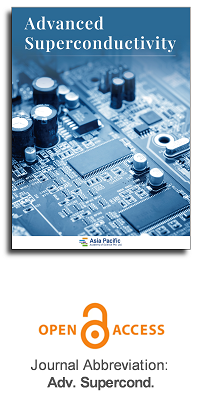
Asia Pacific Academy of Science Pte. Ltd. (APACSCI) specializes in international journal publishing. APACSCI adopts the open access publishing model and provides an important communication bridge for academic groups whose interest fields include engineering, technology, medicine, computer, mathematics, agriculture and forestry, and environment.
The challenges for superconducting wires and tapes today and tomorrow
Vol 1, Issue 1, 2025
Download PDF
Abstract
The main advantages of superconducting wires and tapes is lossless flow of transport current, lossless storage of energy, and generation of high magnetic fields. These advantages can help solve the most critical problems that world faces. Currently, humanity's primary concern is energy security. Humanity for stable development needs cheap, stable, and non-polluting energy sources. A fusion reactor can meet such expectations because it will produce a large amount of stable energy without pollution of the natural environment. This reactor needs cheap superconducting coils and superconducting wires with high critical parameters. Various superconducting wires and tapes e.g. NbTi, Nb3Sn, MgB2, HTS, and iron-based superconductors are being considered and tested. It seems that in the future, MgB2 wires with isotopic boron (11B) may be necessary for fusion reactors because irradiation does not degrade the transport critical current density and has a short decay time of about 1 year [1]. Another crucial application of superconductivity could be the combination of renewable energy sources with superconducting magnetic energy storage. This opens up prospects for cheap and clean energy on a small scale (small family businesses).
References
1. Gajda D, Zaleski AJ, Morawski AJ, et al. Superior engineering critical current density obtained via hot isostatic pressing of MgB2 wires manufactured using nano-amorphous isotopic boron. Journal of Alloys and Compounds. 2021; 871: 159579. doi: 10.1016/j.jallcom.2021.159579
2. Minervini J, Parizh M, Schippers M. Recent advances in superconducting magnets for MRI and hadron radiotherapy: An introduction to ‘Focus on superconducting magnets for hadron therapy and MRI’. Superconductor Science and Technology. 2018; 31(3): 030301. doi: 10.1088/1361-6668/aaa826
3. Olatunji JR, Goddard-Winchester M, Mallett B, et al. Design of a superconducting magnet for space propulsion on the international space station. IEEE Transactions on applied Superconductivity. 2024; 34(3): 3601006. doi: 10.1109/TASC.2024.3353710
4. Liang H, Patel D, Shahbazi M, et al. Recent progress in MgB2 superconducting joint technology. Journal of Magnesium and Alloys. 2023; 11(7): 2217-2229. doi: 10.1016/j.jma.2023.07.010
5. Brittles GD, Mousavi T, Grovenor CR, et al. Persistent current joints between technological superconductors. Superconductor Science and Technology. 2015; 28(9): 093001. doi: 10.1088/0953-2048/28/9/093001
6. Bovone G, Buta F, Lonardo F, et al. Effects of the oxygen source configuration on the superconducting properties of internally-oxidized internal-Sn Nb3Sn wires. Superconductor Science and Technology. 2023; 36(9): 095018. doi: 10.1088/1361-6668/aced25
7. Tomsic M, Rindfleisch M, Yue J, et al. Overview of MgB2 superconductor applications. International Journal of Applied Ceramic Technology. 2007; 4(3): 250-259. doi: 10.1111/j.1744-7402.2007.02138.x
8. Yetiş H, Karaboğa F, Avcı D, Belenli İ. Nano-sized amorphous/semi-crystalline boron ratio and external Mg effects on transport and structural properties in MgB2 IMD wires. Physica C: Superconductivity and its Applications. 2021; 581: 1353807. doi: 10.1016/j.physc.2020.1353807
9. Yamamoto A, Tokuta S, Ishii A, et al. Superstrength permanent magnets with iron-based superconductors by data-and researcher-driven process design. NPG Asia Materials. 2024; 16(1): 29. doi: 10.1038/s41427-024-00549-5
10. Singh SJ, Sturza MI. Bulk and single crystal growth progress of iron-based superconductors (FBS): 1111 and 1144. Crystals. 2021; 12(1): 20. doi: 10.3390/cryst12010020
11. Yang T, Li W, Xin Y. Comparative study of current carrying capacity between 1G and 2G HTS tape samples at different temperatures and magnetic fields. Physica Scripta. 2024; 99(3): 035911. doi: 10.1088/1402-4896/ad2044
12. Noudem JG, Xing Y, Bernstein P, et al. Improvement of critical current density of MgB2 bulk superconductor processed by Spark Plasma Sintering. Journal of the American Ceramic Society. 2020; 103(11): 6169-6175. doi: 10.1111/jace.17366
13. Hossain MS, Senatore C, Flükiger R, et al. The enhanced Jc and Birr of in situ MgB2 wires and tapes alloyed with C4H6O5 (malic acid) after cold high pressure densification. Superconductor Science and Technology. 2009; 22(9): 095004. doi: 10.1088/0953-2048/22/9/095004
14. Gajda D, Babij M, Zaleski A, et al. The influence of Sm2O3 dopant on structure, morphology and transport critical current density of MgB2 wires investigated by using the transmission electron microscope. Journal of Magnesium and Alloys. 2024; 12(12): 5061-5078. doi: 10.1016/j.jma.2024.12.009
Supporting Agencies
Copyright (c) 2025 Author(s)

This work is licensed under a Creative Commons Attribution 4.0 International License.

This site is licensed under a Creative Commons Attribution 4.0 International License (CC BY 4.0).

Prof. Liang Qiao, University of Electronic Science and Technology of China...

